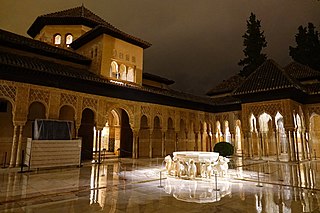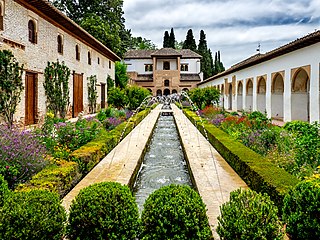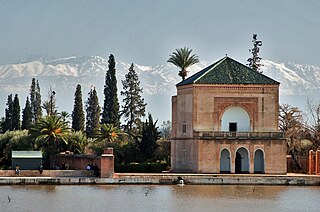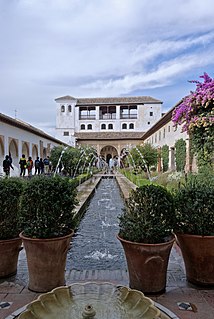 W
WAn Islamic garden is generally an expressive estate of land that includes themes of water and shade. Their most identifiable architectural design reflects the Charbagh quadrilateral layout with four smaller gardens divided by walkways or flowing water. Unlike English gardens, which are often designed for walking, Islamic gardens are intended for rest, reflection, and contemplation. A major focus of the Islamic gardens was to provide a sensory experience, which was accomplished through the use of water and aromatic plants.
 W
WThe Royal Alcázars of Seville, historically known as al-Qasr al-Muriq and commonly known as the Alcázar of Seville, is a royal palace in Seville, Spain, built for the Christian king Peter of Castile. It was built by Castilian Christians on the site of an Abbadid Muslim alcazar, or residential fortress. The fortress was destroyed after the Christian conquest of Seville in 1248. The palace is a preeminent example of Mudéjar style in the Iberian Peninsula, combining Romanesque, Gothic, and Renaissance structural elements. The upper stories of the Alcázar are still occupied by the royal family when they visit Seville and are administered by the Patrimonio Nacional. It was registered in 1987 by UNESCO as a World Heritage Site, along with the adjoining Seville Cathedral and the General Archive of the Indies.
 W
WThe Alhambra is a palace and fortress complex located in Granada, Andalusia, Spain. It was originally constructed as a small fortress in 889 CE on the remains of ancient Roman fortifications, and then largely ignored until its ruins were renovated and rebuilt in the 11th century by the Amazigh king Badis ibn Habus of the Zirid dynasty and later completed in the 14th century by the Arab Nasrid dynasty. It was converted into a royal palace in 1333 by Yusuf I, Sultan of Granada. After the conclusion of the Christian Reconquista in 1492, the site became the Royal Court of Ferdinand and Isabella, and the palaces were partially altered in the Renaissance style. In 1526, Charles I of Spain commissioned a new Renaissance palace better befitting the Holy Roman Emperor in the revolutionary Mannerist style influenced by humanist philosophy in direct juxtaposition with the Nasrid Andalusian architecture, but it was ultimately never completed due to Morisco rebellions in Granada.
 W
WCharbagh or Chahar Bagh is a Persian and Indo-Persian quadrilateral garden layout based on the four gardens of Paradise mentioned in the Quran. The quadrilateral garden is divided by walkways or flowing water into four smaller parts. They are found in countries throughout Western Asia and South Asia, including Iran and India.
 W
WThe Court of the Lions (Spanish: Patio de los Leones; Arabic: بهو السباع) is the main courtyard of the Palace of the Lions in the heart of the Alhambra, the Moorish citadel formed by a complex of palaces, gardens and forts in Granada, Spain. It was commissioned by the Nasrid sultan Muhammed V of the Emirate of Granada in Al-Andalus. Its construction started in the second period of his reign, between 1362 and 1391 AD. The site is now part of the UNESCO World Heritage List and minted in Spain's 2011 limited edition of 2 € Commemorative Coins.
 W
WThe Court of the Myrtles is part of the palace and fortress complex of the Alhambra. It is located east of the Gilded Room and west of the Patio of the Lions and the Baths. Its current name is due to the myrtle bushes that surround the central pond and the bright green colour of which contrasts with the white marble of the patio. It was also called the Patio of the Pond or the Reservoir because of the central pond, which is 34 metres long and 7,10 meters wide. The patio is divided in two sides by the pond, which receives its water from two fountains. The space has chambers and porticoes around it. These porticoes rest on columns with cubic capitals, which have seven semicircular arches decorated with fretwork rhombuses and inscriptions praising God. The central arch is greater than the other six and has solid scallops decorated with stylised vegetal forms and capitals of Mocárabes.
 W
WThe Palacio de Generalife was a summer palace and country estate of the Nasrid rulers of the Emirate of Granada in Al-Andalus. It is located directly east of and uphill from the Alhambra palace complex in Granada, Spain.
 W
WThe Menara Gardens are a historic public garden and orchard in Marrakech, Morocco. They were established in the 12th century by the Almohad Caliphate ruler Abd al-Mu'min. Along with the Agdal Gardens and the historic walled city of Marrakesh, the gardens have been listed as UNESCO World Heritage Site since 1985. The gardens are laid out around a central water basin and reservoir, next to which is a pleasure pavilion dating in its current form from the 19th century. The reservoir and its pavilion, often framed in pictures against the background of the High Atlas Mountains to the south, are considered one of the iconic views and symbols of Marrakesh.
 W
WMughal gardens are a type of gardens built by the Mughals. This style was influenced by the Persian gardens particularly the Charbagh structure, which is intended to create a representation of an earthly utopia in which humans co-exist in perfect harmony with all elements of nature.
 W
WA traditional Spanish garden is a style of garden or designed landscape developed in historic Spain, incorporating principles and elements of garden design from precedents in ancient Persian gardens, Roman gardens and Islamic gardens, and the great Moorish gardens of the Al-Andalus era on the Iberian Peninsula. In the 20th and 21st centuries a 'Spanish Garden,' or new gardens in Spain, have continued, interpreted, abstracted, or departed from these traditional planning and aesthetic motifs.